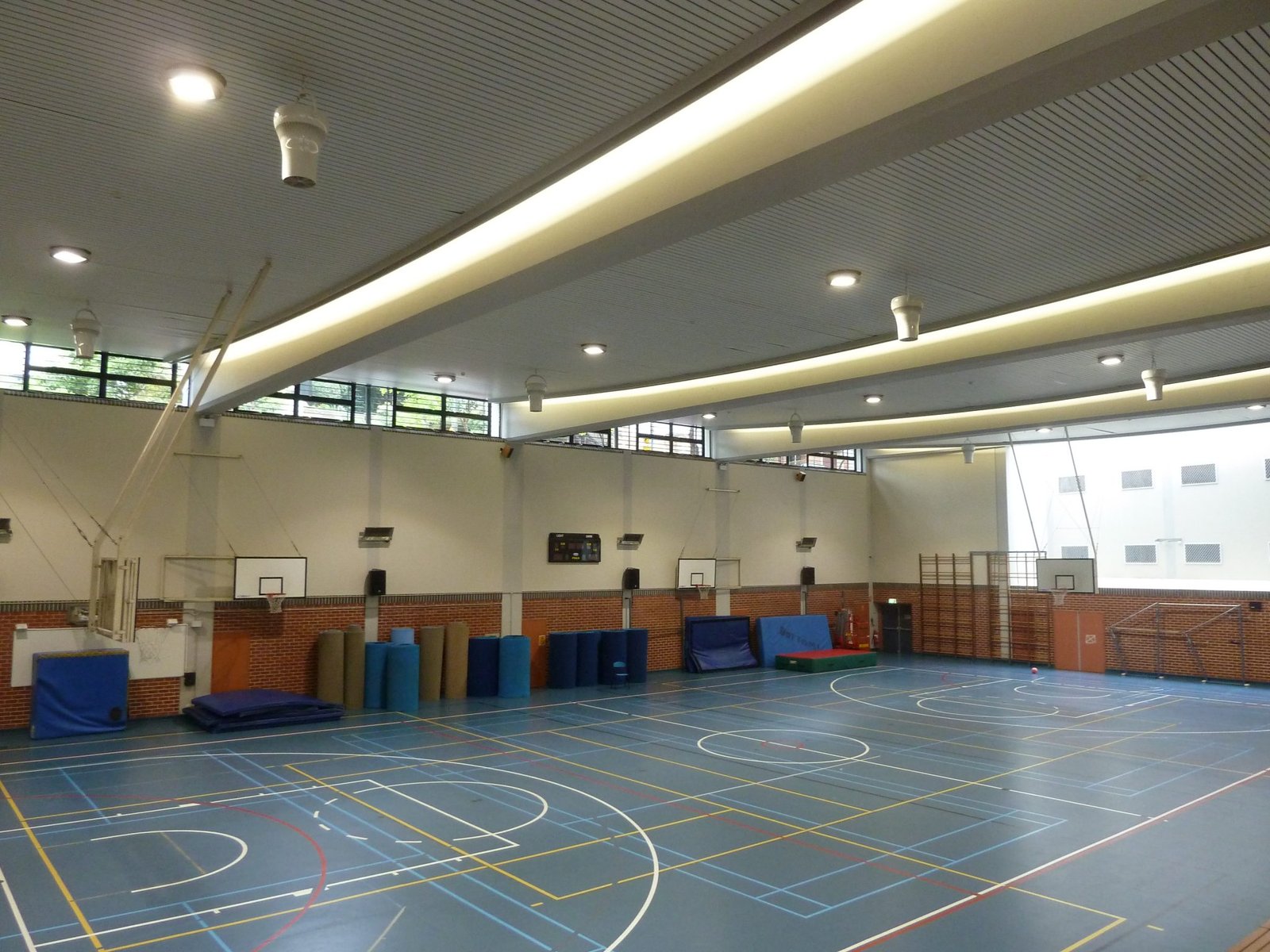
Airius Air Pears and Large bladed HVLS fans V14 80617
Airius Air Pears and Large Bladed ‘High Volume Low Speed’ (HVLS) Fans ..Look! No Blades!
I had an architect ask me the other day why he should use an Airius Air Pear and not a HVLS fan?
I thought that was a pertinent question as we get asked that all the time.
It was once said to me that ‘using a HVLS fan is like watering your garden with a fire hydrant while using Airius units is like watering your garden with a drip feed system.’ Think about that. It’s a good analogy. Drip feed watering systems optimise effectiveness and don’t waste water by putting the water where it is needed, yet the whole garden grows from the use of a drip feed system. Plus, you can strategically place drippers where you need them.
Now let’s be clear; USA manufactured HVLS fans are a good, quality product. They have a good name and a good spread of installations across a range of facilities. They certainly have a particular look and if that look is your key driver in specifying or buying one then you may struggle to consider an Air Pear.
But please don’t discount the Airius product and what value it brings to the table.
Air Pears don’t have large exposed blades like the HVLS fans but they certainly work as well. With many advantages.

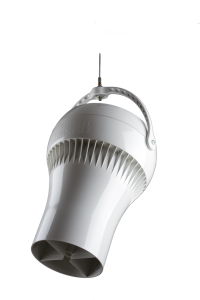
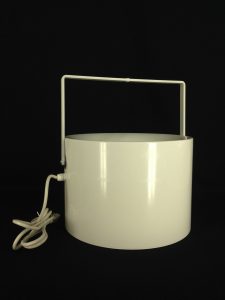
Positives and Negatives in Every Product
Like all alternatives to any product there is always positives and negatives in every option.
Certainly, there have been a lot of architects express satisfaction that Airius products don’t impinge on a space, certainly not like a HVLS fan. Alternatively, some architects like that impingement and visual effect a HVLS fan offers.
But standing back as an outsider, and trying to be objective, there is a range of opportunities that Airius offer that an HVLS fan doesn’t.
The most prominent one is the low impact visually on a space. Airius units are easily installed and can be located to minimise visual disruption while still being effective. As there is a range of products, Airius products can be installed into a much broader number of applications than a HVLS fan while offering a range of different looking units to suit your architecture or function. For example, you won’t see them in supermarkets or offices like you will an Air Pear.
Airius has units that look like large downlights and these can be quite architectural when installed into a space and look very modern.
What about Structural Requirements?
Recently an engineer and an architect told me they find the structural implications of using HVLS fans quite frustrating at times, especially installing them into existing buildings where costly and often intrusive structural changes need to be made. Most HVLS fans require three phase power which can be costly to supply and install. These type of installation constraints can become a real burden for both designers, engineers and facility managers.
The Air Pears don’t have any of those structural impacts on buildings and because they are so lightweight and have such low power requirements they offer a large amount of design and engineering flexibility availability to the architect or engineer. Locations for the units can be simply based upon optimal air flow requirements rather than having to consider lighting strobing, proximity to building users, forklifts, overhead cranes, or sports equipment such as basket or cricket balls. Or as was advised recently, proximity to jumping gymnasts!
The two areas of consideration for Air Pear locations are ensuring they don’t sit directly above any suspended lighting and the ability to find a lightweight fixing point somewhere in the roof or ceiling. That said, the Air Pears only have to be located a small distance away from suspended lighting to provide air flow with no movement of lighting or air flow interruption. The classic example of that is in narrow supermarket aisles where Air Pears are located 200-300 mm from the suspended lights yet there is no impact on lighting or air flow or fridge cases.
A type of large bladed fan
Are there light strobing issues?
One area of concern raised often by lighting engineers and building owners as well as architects, in the use of HVLS fans, is the large blades can create issues around strobing. As they often circulate under lights, they can cause a flicker that workers or those in the space find annoying. We recently won a project for a major freight distribution company where their staff didn’t like the strobing from the installed HVLS fan and in their next facility some of the larger model Air Pears were installed instead of HVLS fans.
That client also raised another issue and that is the impact of overhead cranes in warehouses and the use of large bladed fans. Generally, there is an impact on overhead craneage with the use of large bladed fans as there is often no clearance for both to work in conjunction. The Air Pears, however, are small enough to sit above the overhead crane while supplying strong cooling air movement or gentle warming air flow as required.
In sports halls, as another example, ensuring the HVLS fan large blades don’t interrupt lighting and create strobing or flickering can add extra cost in design and lighting purchase costs, as architects etc. struggle to fit lighting into the space to ensure it provides adequate illumination but is not affected by the rotating blades. Often harder to achieve than it sounds.
We have also had a few facility managers advise us that in sports or learning halls the large rotating blades frighten children, especially if the units are not very far off the floor.
Are There Any Risks of Damage to Air Pears from Balls or Ropes etc.?
In a word, No! As Airius units have no exposed blades there is not a lot of area to target and to damage.
Sports hall providers also often raise concerns about the impact of missiles such as cricket or basketballs or ropes etc. on the exposed rotating blades of HVLS fans. Certainly, in the USA this issue results in HVLS products often being enclosed in large steel cages, or being removed after install due to ongoing damage issues, certainly not an aesthetic or cost effective option.
Airius units are very robust, being a fully moulded product, and are not affected by impact from missiles such as cricket or basketballs.
There is a great ‘you tube’ video which highlights that capability.
https://www.youtube.com/watch?v=9_9c3xjafq0
So you can rest assured, Airius units are tough and resilient and will not suffer from any type of ball or projectile damage.
What About Installation Constraints?
Airius has minimal or no installation constraints. As long as there is an unimpeded air flow to the floor of the facility, there are no installation issues. Just ‘plug and play’.
- No Guy Ropes
- No three-phase power requirements
- No impact from side winds
- No heavy structural supports
As far as installation constraints go here is a great example of the restrictions imposed by HVLS fans on a project.
We recently we provided a solution for an engineer for an outdoor school covered learning area in Brisbane, known as a COLA, where a HVLS fan was specified by the Architect. However, it could only be at a maximum height off the ground of 5 metres, because of the impact of cross winds on the unit, yet the COLA was 8 metres high.
The openness of the space necessitated a large number of guy ropes to be attached to the HVLS unit to ensure stability under cross winds. The use of an HVLS fan also meant a structural and architectural redesign for that facility. And, as a result of that and the low height of the fan from the floor, certain types of activities were banned in that COLA.
However, if they had used an Airius solution, no redesign would have been required and the units would have been installed unobtrusively out of the way with no impact from cross winds, no restrictions on certain activities in inside the space and no structural redesign required, while still offering the same cooling air movement outcome required.
Airius seems like a sensible solution.


Airius units in SCEGGS Darlinghurst, NSW Sports Hall Airius units in St Stephens College Gold Coast Sports Hall
Long Term Maintenance Costs Worries Me.
Over the longer term, ongoing maintenance costs are something you won’t require with an Airius product. HVLS fans have a lot of mechanical infrastructure as far as the motor and gearbox goes and due to the high torque loads created by the large blades, and the requirement to have a gearbox to make the blades rotate in conjunction with an electrical motor, they usually require a yearly maintenance contract.
This results in an ongoing expense and imposition on the operations of the space that is not required with Airius products.
Airius units are mechanically very simple and are a self-contained, ‘plug and play’ solution. Once installed and plugged in, Airius fans can be just turned on and are designed to run 24/7 with no maintenance programme required. Airius have been making them for 15 years so they say they will last 15 years. That’s how good they are.
Is Redundancy an Issue?
We recently visited some sports halls where there were two large HVLS fans installed. Unfortunately, one of the fans was broken down. This highlighted an issue for the client. With only two units installed, and one broken down, the clients had lost half their air movement over the previous two weeks while waiting for a repair. This meant half their hall wasn’t being cooled, creating disruption and annoyance. While Air Pears very rarely fail, as there is usually more than two in a space, (In this instance there would have been 8 Airius units) if one breaks down there will be only a minor impact as there are still another 7 units to provide air flow coverage. Therefore, if using Airius units, there is a much lower redundancy impact and that means you have a much smaller problem.
We Have Gymnastics in Our Space. Will Using Your Air Pears Mean We Can’t Use Our Preferred Springing Floors?
This was a recent query we received and to be honest, it was one we didn’t quite understand. Then, when we attended the site, it all became clear. This nationwide sports hall operator undertook a large amount of gymnastics in their particular building. Unfortunately, because the HVLS fans had to be installed with guy ropes and also had a requirement to be fitted hanging at least a metre down from the roof, the operator had to choose another, less optimal type of springing floor material so as to ensure gymnasts wouldn’t fly up into the rotating blades of the large fans.
The Airius Air Pear fans are small enough, yet powerful enough, to sit up in the roof structure, out of the way of all events, yet still offer the cooling air movement required.
The building owner told us they were frustrated and disappointed at the restrictions the use of the large blades fans imposed on their building and their building users.
They said ‘If only they knew about Air Pears then at time of construction!’
Can Your Air Pears Move Air Horizontally Too?
Of course, HVLS fans are generally used suspended from a roof or ceiling and are designed to direct air down to the floor which Airius units are designed to do as well. Certainly, there are wall mounted versions but to move air sideways, these types of fans require a lot of power for minimal effect. Yet Airius units, with their unique air flow pattern, can also be used horizontally to push air in any direction you require, over a long distance too, and can also be utilised in lieu of duct work to move air around or along, or to and from, a space. Great for heritage buildings for example, or car parks.
Additionally, if under cover, (here is an interesting application) Airius Air Pears can be used externally as they are in Disneyworld in Florida, USA, to provide cooling to customers waiting in long queues. They are simply mounted on a post with a small hood over them and blow air directly at the long queues cooling the patrons. Simple but very effective.

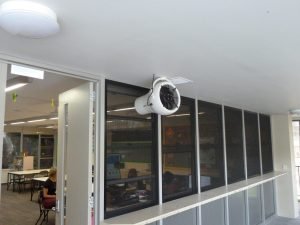
An Airius Air Pear with the Airius custom legs and one horizontally mounted in a school classroom at SCEGGS, NSW.
A HVLS fan cannot do that and typical pedestal fans which are sometimes utilised in that application, are noisy, use a lot of energy and are ineffective in projecting air movement very far. Once again, it’s the shape of air that comes off blades, restricting the ability to move air perpendicular to the blade revolution direction.
It’s a problem with any bladed unenclosed fan. Airius doesn’t have the issue due to their patented and unique air turbine design-that’s a story for another article -see our web site for more information on that.
Do I Have Any Choice of Sizes, Shapes and Colours with An Airius Air Pear?
In regards to range and sizes and shapes, Airius offers over forty different models. The units come in a range of shapes, sizes and motor types, from the traditional Air Pear® with its pear looking shape, to the new and handsome Q50 models, designed for large air flow with an architectural look and very low noise. The Designer Series, that looks like a Q50, comes in an aluminium case and with a full range of motor options similar to an Air Pear, can be supplied in any finish to suit your application from timber veneer to gold braid.
There are also the new ‘Retail Series’ known colloquially as the ‘Eyeball’ and ‘Duckbill’ and they follow the architectural lines of the new Q50 and Designer Series models, only smaller, and are well worth a look. Superbly engineered and designed primarily for supermarkets but suitable for a range of applications such as car showrooms or schools or offices, libraries etc, up to 7 metres high, these new units are very effective and very quiet.


The new Retail series R20 ‘Duckbill’ and ‘Eyeball’. The new Airius Q50 for Sports Halls, Theatres etc.
And, now, there is the new domestic series, designed for apartments, aged care facilities, hotel rooms, houses and bathrooms etc. that looks like a mini version of the ‘Eyeball’. All of these units have different motor and control options, offering great flexibility in location and operations.
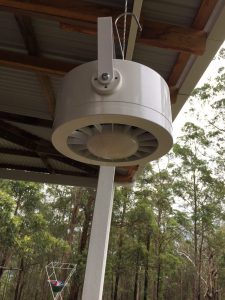
The new Airius ‘Domestic’ Series
What if I want to move them?
Now, if for some reason, you want to relocate from your existing facility or want to do a refurbishment, the removal and relocation of our units is simple and fast. Just unplug from the power and unchain from the hanging point and you can store or relocate the units as required. That lightweight portability is a great asset in many applications.
How many units will I need?
When considering an Airius Product or a HVLS fan in the larger spaces you will generally require more Air Pears than HVLS fans. However, in say classrooms where the smaller HVLS ceiling fans are used then the numbers of Air Pears will be similar or even less than the HVLS fans.
And, Airius products have the ability to be located in a ceiling (using our unique ceiling kit) out of the way with minimal visual and distracting influence on the attendees in the space. They also offer a lot more flexibility in install locations.
Due to the unique Airius air flow shape, it is possible to ensure you distribute air flow to some areas and not others if that is a requirement. Say, for example, you needed to circulate air in a class room but not directly onto people, you could utilise a specific Airius unit like the new ‘Duckbill’ with its elongated air flow footprint to blow along the very narrow aisles between the desks, rather than the traditional Airius circular air flow footprint.
The use of Airius units in conjunction with air conditioning is another area HVLS fans can’t be utilised. Take, for example, Coles stores, they utilise reclaimed heat and pipe that into the top of Airius Air Pears and then use the Air Pears to force that heat to the floor in their cold aisles, with no impact on their fridges. Outside of supermarkets that’s not a common application but it certainly shows the flexibility of Airius products.
This application can also be used where there is a ‘dead leg’ on air conditioning systems and the Air Pear can be used as a powered diffuser, helping to draw the air out of the duct and into the space.
Is there a difference in performance?
When it comes to air flow, which is why we specify fans, certainly in summer Airius and HVLS fans perform similarly. We move air, they move air and cooling is achieved. We just use different technologies to achieve a similar outcome.
And Airius fans can move a lot of air at ground level if required. Take Sports Halls for example. They need a lot of air movement for cooling and Airius Air Pears can provide that. To ensure your building users are more comfortable in summer.
So in summer … Yes, your cooling requirements will be achieved. (See our ‘Science of Cooling’ blog for information on the science of air movement and cooling).
All our units will work together as one, entraining all the air in the space and creating one large moving air mass.
However, in winter, while the HVLS fan will achieve a good result for most of the zone, Airius products are unmatched at forcing the lighter warm air rising to the ceiling, back down to the floor. The unique air flow shape provided by Airius products ensures that any Airius ‘air turbine’ can force that warmer air down where it belongs by simply pushing through the thermal layers (stratification) found in every building. The greater temperature difference between floor and ceiling, the harder it is in winter or summer, to force warmer air to the floor. That’s where Airius excel.

Smoke test visualisation of Airius unit
What About Pricing Difference and Installation Costs?
Price wise generally Airius units are cheaper to supply and install. Often a lot cheaper!
Usually around a minimum of 25% cheaper.
We recently were told of an example for a single basketball court in a QLD state school where the HVLS fan supply and install price for 4 x HVLS fans was $62,000.00+ -in an 800 sq metre space.
Plus, other requirements ….
- three phase power was required -$7,000
- Plus, an ongoing $2,500 per annum maintenance contract,
- Plus $3,000-5,000 of structural roof works needed to support the fans
The Airius price to supply and install the same facility was around $24,000.00+. With no ongoing or hidden costs. No constraints. No redesigns. No strobing. No maintenance contracts. Etc. Etc.
With the same outcome.
That’s a $50,000.00 saving! What would that buy for your business?
(Please note -each project is different and costs vary depending on height, floor area, and application.)
Another example we recently saw was a 500 sq. metre basketball court –$24,000.00 plus GST for the supply and install of two x HVLS fans. However, the client had to spend another $28,000.00 on three phase power and roofing structure to take the fans.
That is around a $52,000.00 plus GST cost to the client.
The Airius supply and install costs for the same location?
$17,000.00 plus GST.
A saving of $35,000.00 by using Airius!
While an unusual situation, even without such a magnitude of extra over costs, the client has experienced significant savings using the Airius solution.
Based on initial costs only (as Airius has no long-term or any maintenance contract to be considered) Airius installations are usually always cheaper. Significantly Cheaper.
And no ongoing costs… making the Airius units add value every year.
And …… Airius offers a lot of flexibility around the installation process because any licenced electrician can easily install them.
This means you can utilise your own electricians or if you require you can use one of our trained installing teams. There are no assembly requirements and no risk of assembling parts incorrectly. As the Airius Air Pear is a self-contained unit, it’s a very simple project to: –
- Unpack out of the box
- Add a plug to the already fitted power cable end
- Run a power point to the location
- Attach a chain or cable to the unit and to the roof or ceiling structure
- Connect power and turn on
- Adjust speed
- Walkaway
Do the Airius Units Have Speed Control Capabilities?
Airius has a broad range of motors and offers a full range of speed control options: –
- Standard SC-01 and SC-05 Speed Controllers -low noise transformer type speed controllers for our PS2, 4 and split capacitor motor types.
- Potentiometer Speed Control -for use with our EC motor range.
- Triac Electronic speed controllers for a lower cost speed control option
- Full BMS control capability -to tie in with your air conditioning and other building operational demands.
- Full Zigbee wireless control systems on all EC motor options.
HVLS fans also offer speed control capabilities similar to the options Airius offer above so both units are similar in that regard.
What About Power Consumption?
Airius units use very low amounts of power to create air movement. That is part of their unique air turbine design. The most powerful Airius unit uses 400 watts -single phase only – and it’s for buildings between 25-40 metres high!
In sports halls, up to 10 metres high -the most commonly used Airius unit is the Model 60 PS4 and each unit uses only 120 watts…single phase – similar to an old light globe.
So, no, not a lot of power consumption.
What about Warranties?
Airius offers a 5-year full replacement + 5-year half new price refurbishment programme warranty with no pro rata provisions and most HVLS products offer a variable warranty programme subject to a range of conditions with some pro-rata components.
As the Airius product is a simple unit and install is the same as a high bay light or fluorescent trough lamp, the warranty is not predicated on the installer being approved by Airius, only that they are a licenced electrician. That may not be the same for HVLS fans and warranties and length of warranties etc. may be predicated upon the use of approved HVLS installers.
Now to be fair, HVLS fans offer some functions that Airius products don’t at this time. For example, only the new domestic Airius unit has a remote controllable LED light built into it. That option is coming to other Airius units over the next twelve months or so.
However, just in case, if you want to attach a camera or a logo to our units, for example, that can be arranged too.
So, in summary let’s review what we have discussed here today.
| Airius Units | HVLS fans |
| No exposed blades | Exposed blades |
| Unobtrusive | Obtrusive |
| Pricing usually significantly cheaper >25% less | Pricing usually significantly more expensive than Airius |
| Great at Cooling | Great at Cooling |
| Excellent at destratification in winter | Very good at destratification in winter |
| No strobing of lighting | Risk of strobing of lights |
| No maintenance contract | Yearly maintenance contracts on some units |
| Low wattage single phase power | Generally three phase power requirements |
| Not affected by cross winds | Affected by cross winds |
| No structural install requirements -simple install | Structural install requirements |
| No guy ropes required | Guy ropes required in some installs |
| Directional air flow control | No directional air flow control |
| No clashing with overhead cranes | Can clash with overhead cranes |
| No damage from basket or cricket balls, ropes etc. | Possible risk of damage to blades from basket, cricket balls, ropes etc. |
| Horizontal air flow capability | Poor horizontal air flow capability |
| Ductless duct option | No ductless duct option |
| Easily relocatable | Not easily relocatable |
| Quality USA product | Quality USA product (brand specific) |
| Generally, more units in a space | Generally, less units in a space |
| Large range of looks, shapes, colours and sizes | All units look like big fans but a range of fans |
| Very broad range of applications | Limited range of applications |
| Overhead LED lighting in domestic unit only | Overhead LED lighting available |
| In ceiling, flush mounting option | No in ceiling flush mounting option |
| Full speed control | Full speed control |
| BMS control | BMS control |
| Wireless control capability | Wireless control capability TBC |
| 5 + 5-year warranty programme | 3-12-year pro rata warranty programme |
| Range of colours available | Range of colours available |
| Low noise | Low noise |
| Scores of Thousands Sold | Tens of Thousands Sold? |
In closing, both products (if the HVLS fans are the USA manufactured versions) are good quality and well-engineered and both have been market leaders in their fields for many years.
However, with outcomes in performance being similar, it’s worthwhile considering the lack of constraints and therefore significant advantages of using an Airius unit.
Please contact us at www.airius .com. au to find out more or call us on +61 401 848 888.
The chart below supplied by a HVLS fan manufacturer, highlights how a large bladed fan moves air in exactly the same direction and air flow pattern as an Airius Air Pear. The only difference is Airius generally use a larger number of much smaller units and lower cost to achieve the same outcome.
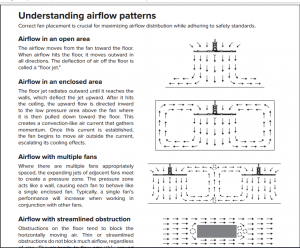
This chart above is provided by a large blade fan manufacturer and highlights how their air flow moves in summer cooling.
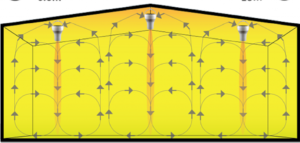
This image above of Airius Air Pear units in operation highlights how the air flow pattern is similar to that of a HVLS product. It’s just that one uses large exposed blades and one doesn’t. Eventually the Air Pears air flow pattern will start to rise back up to the roof again and continue recirculating as does the HVLS fan air flow pattern.
Outcome is the same -methodology is different.



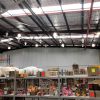
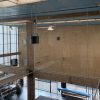

Dear Sir/Mdm,
Good day to you.
I’m looking for this product. Kindly please send me some catalogues and the price for this product?
Thanks
Kind regards,
Stephanie
Hi Stephanie. Please email me at [email protected]